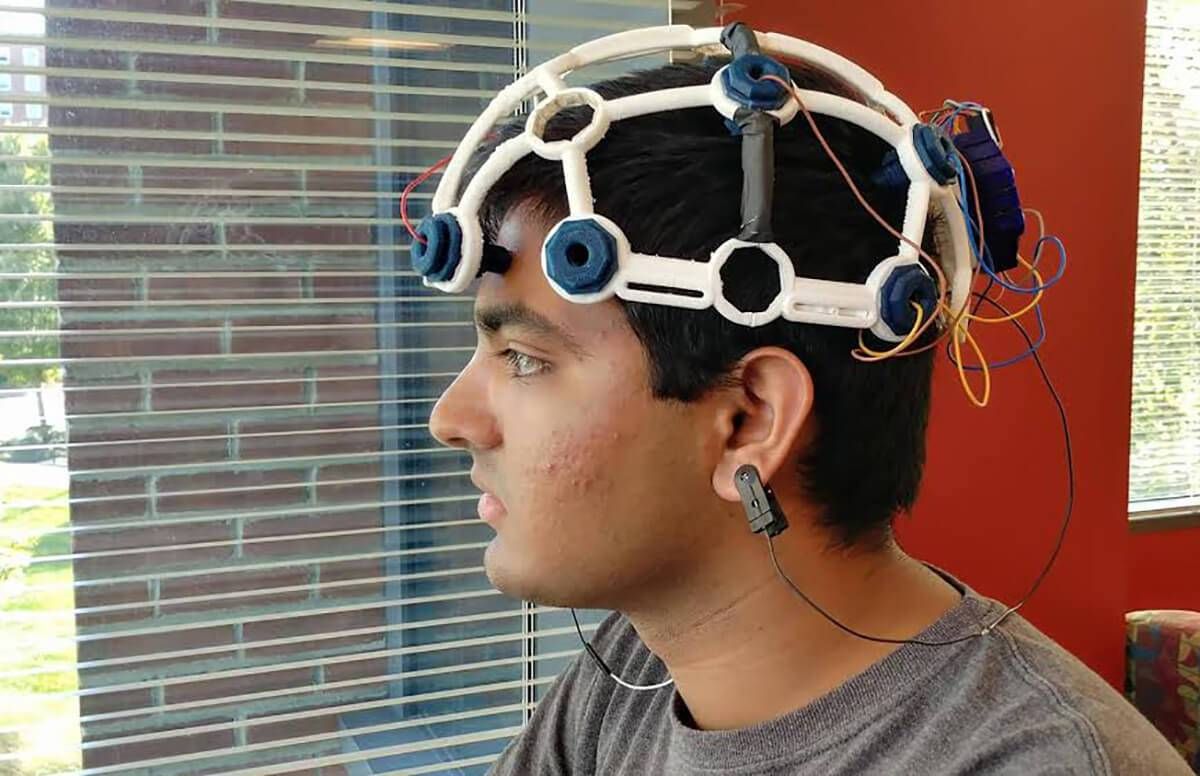Can This New Gadget Diagnose Alzheimer's?
Students at the University of Maryland won a national prize for their invention
The many boomers who worry they might get Alzheimer’s or who have relatives with Alzheimer’s often have two wishes for the next scientific breakthrough. One is a method for accurate diagnosis. The other is effective treatment.

Currently, the only definitive diagnosis for Alzheimer's comes from an autopsy. But a team of sophomores at the University of Maryland, College Park, just won first prize in a National Institutes of Health (NIH) competition for their prototype portable EEG device to diagnose Alzheimer’s.
“The solution is really smart and has the potential to really work,” said Zeynep Erim, program director at NIH’s National Institute of Biomedical Imaging and Bioengineering and a judge in the contest. She was impressed by the students’ entry in the Design by Biomedical Undergraduate Teams (DEBUT) Challenge.
From Concussions to Alzheimer’s
The spark for their design came when they were looking for ideas for competitions. At the time, there was a lot of discussion of concussions in professional football players. The students were thinking of using an electroencephalogram (EEG), a test that records the electrical activity of the brain, to diagnose brain waves for concussion.
When that didn’t work out, “I thought, what if we used an EEG to diagnose Alzheimer’s?” said Dhruv Patel, a co-leader of the winning student team. “There was a lot of literature on it, but nothing was brought to market.” Both Patel and Christopher Look, the other team leader, had relatives who had died of Alzheimer’s, and the students thought this could be a way their research could help others.
The EEG used in a doctor’s office or a research lab has as many as 256 electrodes and is the size of a desk. “That’s fine for R&D,” said Patel. But his team didn’t need that extreme degree of accuracy for their research.
“We just wanted to take eight or 16 electrodes and record brain waves,” Patel noted.
A More Workable Design
They hit on the idea of using a portable EEG with an open source headset, the Ultracortex by OpenBCI, and connecting it to a laptop computer. The headset cost less than $2,000, while most EEG machines cost hundreds of thousands.
“Researchers around the world had already done research on machine learning [a type of artificial intelligence] that reads the brain signals and finds patterns in healthy patients and those with Alzheimer’s,” said Look. He and his team extracted features from brain signals and asked the computer what kinds of patterns it saw.
“I have the machine predict whether that person has Alzheimer’s or not,” Look said. The small-scale trial the students did was with existing data from other studies. The machine, using data from the portable EEG and mathematical algorithms created by the students, was able to predict Alzheimer’s in those patients with 83 percent accuracy.
“It’s definitely not diagnostic yet, but I think it gives it some value,” said Look.
Potential for More Quantitative, Less Costly Diagnosis
NIH calls the device “a noninvasive and relatively inexpensive tool with the potential to detect Alzheimer’s disease with a high level of accuracy.” The agency says the device “could make dementia diagnosis more quantitative, systematic and less costly — allowing doctors to use it at regular checkups.”
The next step for the students is figuring out if they want to pursue research for early diagnosis or for diagnosis of current patients. Either would be an improvement. The most widely used diagnostic tools now are a questionnaire, the Mini-Mental State Exam (MMSE), and an MRI and PET scan, which are expensive and disruptive.
“Our goal is to lower the barrier of getting a diagnosis,” said Look. “One of the reasons people don’t do tests now before they see symptoms is that the test is very expensive, a huge hassle and takes a lot of time. We’re hoping to do a one-time, very quick, very cheap way to get this done.
“If this [test] can tell you there’s something wrong or you just need further testing, it [the device] could still be valuable to a patient,” Look said.
An early diagnosis could be even more useful. But testing the accuracy of the device for early diagnosis would require a multi-year study that could cost as much as $200,000. The students are looking into grants so they can test their own data and their own machine and prove their algorithm is functional and accurate when tested on a large number of people, said Look.
“We want to get to the point where we can say the data shows a person has a very high chance of getting Alzheimer’s, with 98 percent or 99 percent accuracy,” Patel said.
Diagnosis Without Treatment
But Jennifer Deal, an epidemiologist and gerontologist at Johns Hopkins University School of Public Health, urges caution. “The key feature is to identify people before the onset” of the disease, she said. “That’s going to be the real trick.” And that’s much harder than diagnosing current Alzheimer’s patients.
Another big question, said Deal: “Is there a treatment that can change the course of the disease? No. To my mind, that’s one of the big issues.” One possible course — though more a benefit for others than for the patient — would be to enroll people in the very early stages of Alzheimer’s in clinical trials testing possible treatments.
Another potential benefit in diagnosing Alzheimer’s patients, even when no good treatment exists: “If they know [they have the disease], it helps them work with their family and caregivers, to know what they want in the future,” said Deal.
Some treatments for Alzheimer’s can slow the worsening of symptoms, according to the Alzheimer’s Association. But that effect doesn’t last. So effective treatment is the next crucial frontier.

